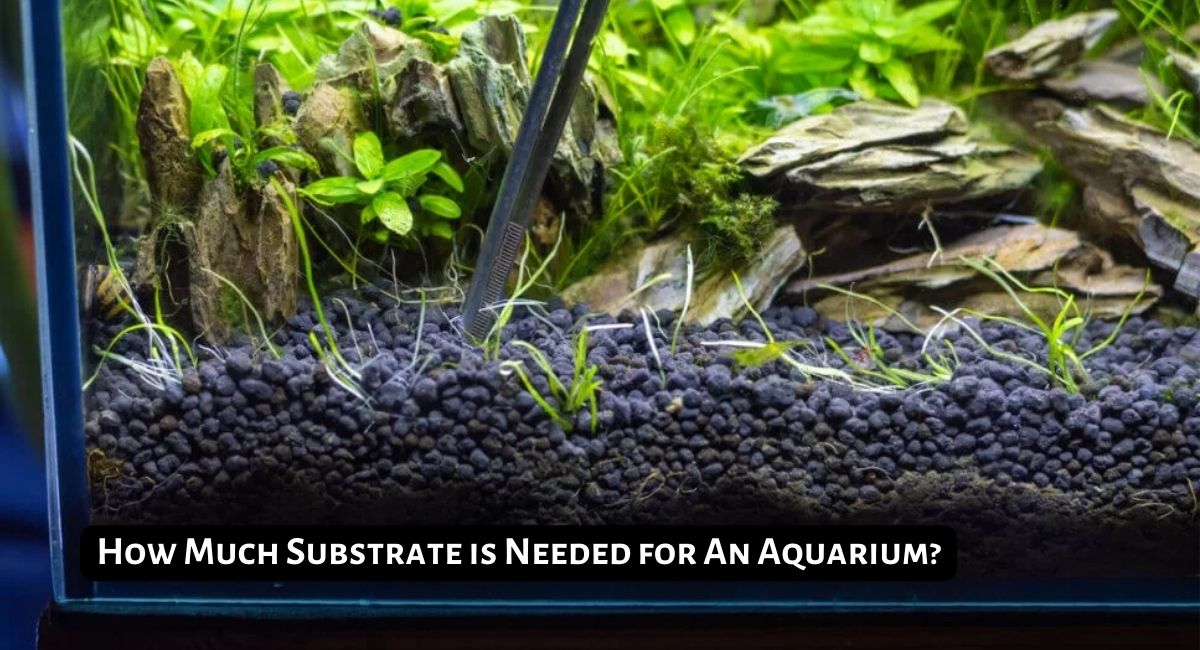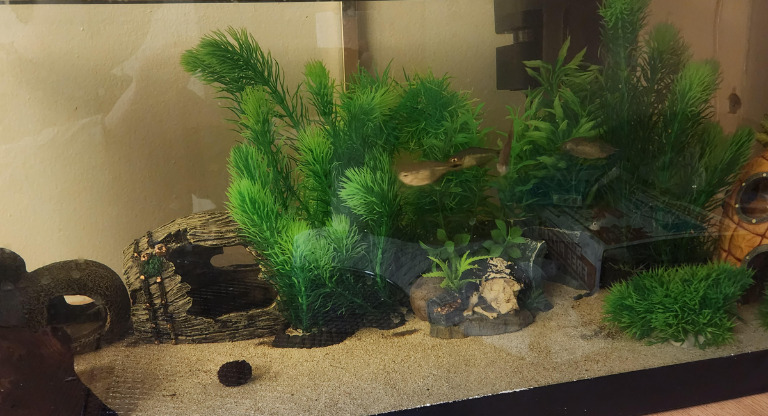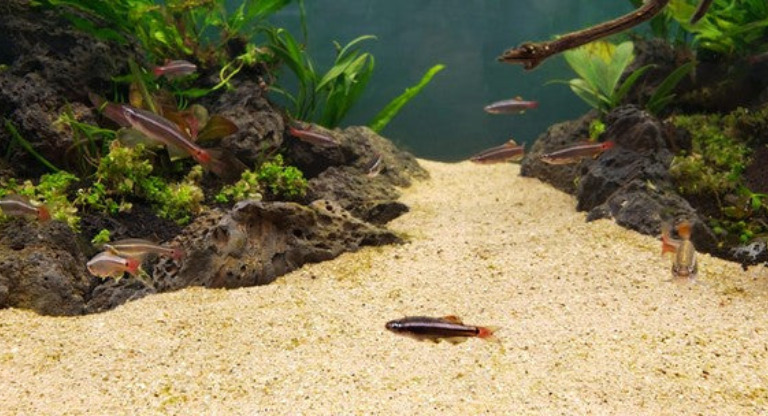Smartplantedaquarium.com participates in affiliate marketing programs. We may earn commissions on purchases made through our affiliate links. This doesn't affect our content or recommendations and we only recommend products we would put in our own tanks.
Creating a thriving underwater ecosystem in your aquarium is more than just selecting the right plants and fish. It also involves choosing the ideal aquarium substrate, which covers the bottom of your aquarium and serves several critical functions. This material anchors aquatic plants, nurtures beneficial bacteria, and bestows a natural appearance upon your aquatic haven.
To ensure the health and well-being of your underwater world, it’s essential to select the appropriate type and amount of substrate.
This guide will assist you in making an informed decision, outlining critical factors to consider when selecting the perfect substrate and providing instructions on proper installation. Whether you’re a novice aquarium keeper or a seasoned expert, the information contained within will be priceless as you cultivate a captivating and healthy aquarium environment.
TL;DR
The amount of substrate needed for an aquarium depends on the size of the tank, the type of fish or plants being kept, and the desired depth of the substrate layer. As a general rule, a depth of 2-3 inches is recommended, and the substrate should be rinsed before use to remove any debris or dust. It’s also important to choose a substrate that is appropriate for the aquarium’s inhabitants and provides the necessary nutrients for plants to thrive.
Contents
How Much Substrate Do You Need for Aquarium
If you’re setting up an aquarium, one of the most important decisions is calculating how much substrate you will need. Aquarium substrates are a key component in creating a healthy and thriving environment for your fish, as they help to maintain water quality and provide an aesthetic appeal. But before you can start adding substrate to your tank, you’ll need to know how much substrate to purchase.
The first step in calculating the amount of aquarium substrate you need is to measure your tank. Aquarium substrates come in various sizes, so you’ll want to make sure that the substrate you buy is suitable for your tank size. Once you have measured your tank and determined the size of substrate you need, you can move on to calculating how much substrate is required.
- Measure the length, width and height of your aquarium in inches
- Multiply the measurements together to calculate the volume of your tank in cubic inches
- Choose the substrate size you would like to use – coarse gravel, fine sand or a mixture of both. Aquarium substrates generally range from 0.5mm – 5mm in size.
- Aquarium substrate calculator requires the density of your chosen material, which can be found on the packaging
- Calculate how many pounds of substrate you need to fill your tank by dividing the volume (in cubic inches) by the substrate’s specific gravity – this value is usually available from manufacturers
- Aquarium substrate calculators are available online to help you with this calculation
- Aquarium substrates generally require a depth of 1-2 inches. Multiply the area of your tank by the depth desired and divide this number by the density of your chosen material to get an answer in pounds
- Last but not least, it is important to factor in the displacement of ornaments, rocks and decorations when calculating the amount of substrate required. These items displace the substrate, meaning you need more than what was originally calculated
- Aquarium substrates should be replaced every couple of years to ensure your tank remains healthy. Calculating the right amount is key to maintaining a balanced ecosystem in your aquarium.
It’s also important to choose the right type of substrate for your aquarium. Some popular options include gravel, sand, and specialized substrates like aquasoil or planted tank substrates. Consider the needs of your fish and plants when selecting a substrate, as some may require specific types of substrate to thrive.
Once you have the right amount and type of substrate, it’s important to maintain it properly. This includes regular vacuuming to remove debris and uneaten food, as well as monitoring the pH and water hardness levels to ensure the substrate is not causing any imbalances in the water chemistry.
Aquarium Substrate Calculator
To use an Aquarium Substrate Calculator, you will need to know the size of your aquarium and the depth of substrate you wish to add. The calculator will then tell you how many pounds or kilograms or litres of substrate to buy.
- Determine the area of your aquarium’s floor. This is calculated by multiplying the length by the width. For example, if your aquarium is 24 inches long and 12 inches wide, the area would be 288 square inches (24 x 12 = 288).
- Decide on the desired depth of your substrate. This can vary depending on the type of aquarium you have and the types of plants or fish you plan to keep. A general rule of thumb is to have a substrate depth of at least 2 inches for planted aquariums.
- Calculate the volume of substrate you need. To do this, multiply the area of the floor by the desired depth of the substrate. For example, if you want a substrate depth of 2 inches in an aquarium with an area of 288 square inches, you would need 576 cubic inches of substrate (288 x 2 = 576).
- Convert the volume to the appropriate units. If you’re using a pre-packaged substrate that comes in pounds, kilograms or litres, you’ll need to convert the cubic inches to that unit of measurement. For example, if you’re using a substrate that comes in 10-pound bags, you’ll need to divide the cubic inches by the number of cubic inches in 10 pounds. To convert cubic inches to pounds or litre, divide the cubic inches by 61.0237. To convert cubic inches to kilograms, divide the cubic inches by 3,543.
- Purchase the appropriate amount of substrate. Once you’ve determined how much substrate you need and converted it to the appropriate units, purchase the amount you need. It’s always a good idea to buy a little extra just in case, especially if you have an irregularly shaped aquarium or want a particularly deep substrate.
Conclusion
In conclusion, substrate is an essential component of any aquarium and plays a critical role in maintaining the health and well-being of your fish. Choosing the right type and amount of substrate for your aquarium can make a significant difference in the overall health of your fish and the cleanliness of the environment.
By understanding the different types of substrates and how to properly maintain them, you can create a healthy and thriving ecosystem for your aquatic pets. Remember to test your water regularly and adjust your substrate as needed to ensure the best possible conditions for your fish. With a little bit of knowledge and care, you can create a beautiful and healthy aquarium that you and your fish can enjoy for years to come.
Frequently Asked Questions (FAQs)
1. How thick should a substrate be for an aquarium?
The thickness of a substrate for an aquarium typically depends on the size of the tank and the type of fish or plants being housed. As a general rule, a substrate layer of 2-3 inches is sufficient for most aquarium setups, but thicker substrates of 4-5 inches may be necessary for certain types of fish or plants. It’s important to research the specific needs of your aquatic pets and plants before determining the appropriate thickness of substrate for your aquarium.
2. How much substrate sand for an aquarium?
The amount of substrate sand needed for an aquarium depends on the size of the tank and the desired depth of the sand bed. As a general rule, a layer of sand that is 1-2 inches deep is sufficient for most aquarium setups. To determine the amount of sand needed, multiply the length and width of the tank in inches to get the total surface area, and then multiply that number by the desired depth of sand in inches. This will give you the total volume of sand needed in cubic inches, which can be converted to pounds based on the weight of the specific type of sand being used.
What is the minimum depth of substrate?
The minimum depth of substrate for an aquarium depends on the type of fish or plants being housed. As a general rule, a substrate layer of at least 1 inch is recommended to provide a healthy environment for most aquatic species. However, certain types of fish or plants may require a deeper substrate layer to thrive. It’s important to research the specific needs of your aquatic pets and plants before determining the appropriate depth of substrate for your aquarium.
How do I calculate soil for my aquarium?
To calculate how much soil you need for your aquarium, you’ll need to measure the length, width and depth of the tank. Multiply these three measurements together to get the volume of your tank in cubic centimeters (cm3). Then,Take this figure and divide by 1000 to convert it into liters. You can then multiply this number by the type of soil you will be using (e.g., a sandy substrate or clay-based soil) to get the approximate amount of soil required for your aquarium in liters.
How much substrate do I need per gallon?
The amount of substrate you need depends on the type of aquarium and the size of the fish or other inhabitants. Generally, one pound of gravel is recommended for every two gallons of water, but this may vary depending on your specific setup. Additionally, if you have larger fish or if the tank has a lot of decorations and rocks, then you may need to add more substrate. It’s important to remember that the substrate plays a critical role in the health of your aquarium, so make sure there is enough for the size and type of tank you are setting up.
How much gravel do I need for a 100 Litre tank?
The amount of gravel needed for a 100 litre tank depends on the size of your aquarium and the type of gravel you are using. Generally, you will need at least 1 kilogram (2.2 pounds) for a shallow 10-centimetre (4-inch) layer in the bottom of your tank. If you want to create a deeper layer, you may need more. As a general rule of thumb, use 1 kilogram (2.2 pounds) for every 10 centimetres (4 inches) of aquarium depth. Additionally, if you are using larger pebbles or stones instead of gravel, you may need to adjust your measurements accordingly as they will take up more space in the tank.






